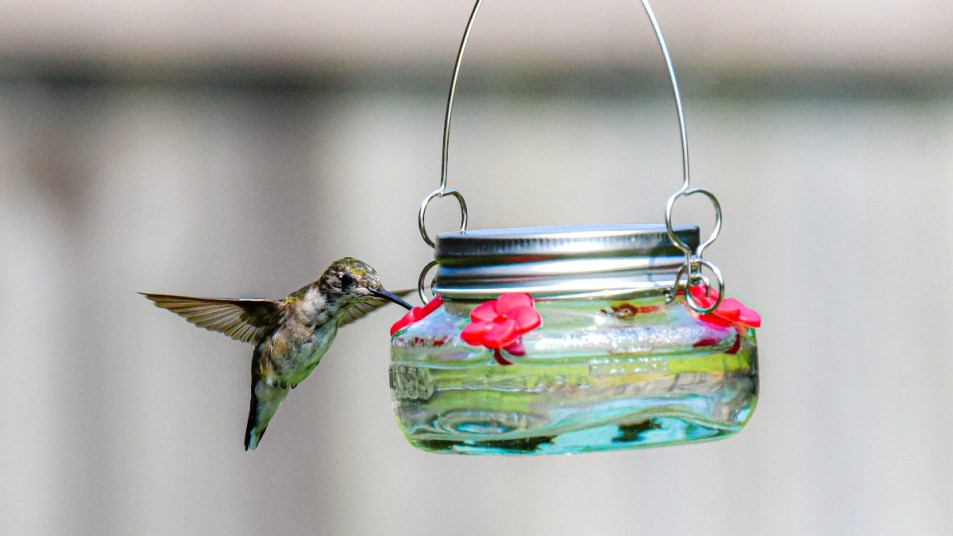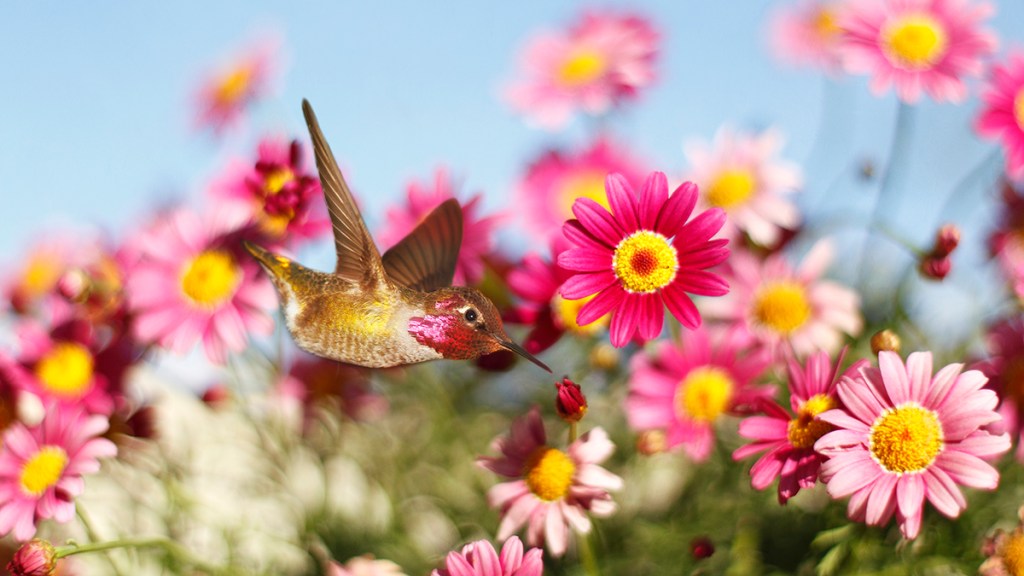How to Attract Hummingbirds to Your Yard + the One Thing You Should *Never* Feed Them
All you need is a small mason jar, some plain old cane sugar and 10 minutes!

With their vibrant colors and fast-moving flight, it’s no wonder people can’t help but marvel at hummingbirds! These tiny birds, which include more than 360 different species, are a delight to see fluttering around your yard or garden. And it’s easy to make your space a hot spot for hummingbirds — all you need is a feeder and food! Below, a hummingbird expert shares how to make a DIY hummingbird feeder and food, plus tips on what to look for when buying a feeder and other surprisingly simple ways to attract the birds.
“I always encourage people to learn more about hummingbirds because they are such fascinating creatures and so endearing to us because of their frenetic antics and their adaptability in becoming neighbors with us, their human hosts,” says John Shewey, author of The Hummingbird Handbook.
How to make hummingbird food
An easy way to attract these magnificent birds to your yard is by making your own food and placing it in a special feeder.
“Hummingbirds feed on flower nectar, and sugar water is a similar substitute,” shares Shewey.
Thankfully, sugar water is a cinch to whip up yourself. To do: Use four parts water to one part sugar. Boil the water, let cool a bit, then stir in the sugar until it is dissolved.
Note: “Never use organic sugar, raw sugar, molasses, red dye or food coloring — all of these have various chemicals and other substances that can be harmful to hummers,” he adds.
You can keep the sugar water can in the refrigerator for up to a week, but it’s important to empty, clean and refill your feeders every 2 to 3 days in warm weather and every 4 to 5 in cold weather. When sugar water ferments, mold begins to form, which can be dangerous for the birds to ingest. Regularly changing the homemade food keeps it safe for them!
How to make a DIY hummingbird feeder
Now that you have your hummingbird-approved sugar water prepared, you’ll want to add it to a feeder so the birds can enjoy it. The good news? You don’t have to shell out for a store-bought version.
“One of the simplest homemade feeders can be made from a small-size shallow Mason-style jar,” says Shewey.
His how-to:
- Use a hammer and nails to punch a series of 1/8” holes in the jar lid. Repeat until you’ve created 6 to 8 holes arranged in a circular pattern in the lid.
- In the middle of the lid, punch an additional hole (This will be for an eye-bolt, from which the feeder will hang).
- Turn the lid over and use a metal file to soften the edges of the metal where you punched the holes.
- If desired, paint the top of the lid and the metal rim bright red to ensure it stands out to the birds. Let dry.
- Twist a small eye-bolt (the kind with a nut, rather than the screw-type; buy on Amazon $7.86 for a 10-pack) into the hole in the center of the lid and lock it in place with the nut that comes with it.
- Fill the jar with sugar water and hang in a location with lots of shade.
- When the feeder needs to be cleaned, you can hand wash it or run the jar portion through the dishwasher. Add fresh sugar water before hanging the feeder again.
What to look for if you prefer to buy a feeder
There are generally two kinds of commercially made options available: bottle-style and saucer-style feeders, and Shewey prefers the saucer-style feeders, like the Aspects HummZinger (Buy from Amazon, $25.97). “They are so easy to clean,” he says. “Moreover, they are naturally bee-proof. Bees can’t get to the sugar water because the small holes in the feeder lid are raised above the level of the sugar water.”
No matter which one you choose, he recommends looking for a feeder with a built-in “ant moat” feature, which is helpful to keep out sugar-loving ants.
“It’s a cuplike feature at the center of the saucer lid that you fill with water to prevent ants from being able to climb down the feeder hanger and then get to the little holes from which the hummers feed,” says Shewey.
Other ways to welcome hummingbirds
Although any visiting hummingbirds will surely appreciate your feeder filled with sugar water, there are other ways you can attract them to your yard and support their dietary needs.

“Nectar fuels their warp-speed lifestyle, but just like us, they also need proteins and other nutrients they can’t get from sugar, so hummingbird eat tiny bugs — lots and lots of tiny bugs,” says Shewey. Leaving a rotting peeled banana on a plate in your garden, for example, can attract fruit flies and other bugs that the birds can enjoy. (Don’t throw out the peel! Click through to learn how to use a banana peel to keep plants healthy ward off wrinkles and more!)
“Let bugs be and leave spiders and spiderwebs alone — hummingbirds use spiderweb silk to bind their tiny nests,” he adds.
Native plants are also a fantastic way to support wildlife like hummingbirds. “Hummingbirds feed from many thousands of different flowers so it’s hard to go wrong, especially if you select flowers with tubular blossoms in shades of red, orange, pink and purple,” explains Shewey. He recommends plants like Bee Balm, Hummingbird Mint (Agastache), hanging-basket fuchsia, native honeysuckle, and Salvia. All are popular choices with hummers! Click through for more hummingbird-friendly plants to add to your space.
Finally, you can really turn your yard into a hummingbird haven by incorporating other elements such as water features (like a mist hose), shade trees and places for hummingbirds to perch. This can even be something as simple as empty tomato cages!
A version of this article originally appeared in our print magazine, Woman’s World.
Click through for more bird feeder advice:
7 Genius Ways to Keep Squirrels Out of Your Bird Feeder — One Will Work For You!
Is Your Bird Feeder Spreading Bird Disease? Here’s How To Clean It Safely












